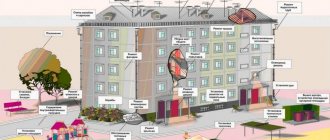What the law says about lighting the local area of an apartment building
The surrounding area is the space around residential buildings (administrative complexes, private and public buildings).
The area adjacent to the house is called the home area. It includes all land plots near the house (both private and multi-apartment), regulated by the right of ownership or use of the site and intended for servicing the house, namely:
- Ground under the building.
- Walkways and sidewalks, playgrounds, lawns and flower beds.
- Areas for recreation and sports.
- Car parking.
- Reasons for economic needs.
Knowing what the territory of the house is and what its boundaries are, residents can protect themselves from illegal buildings inside their yard (kiosks, counters).
Such territories must necessarily have demarcated areas. For such cases, geodesy is used. Geodesy (surveying) is a method of establishing the boundaries of a piece of land using surveying methods. It includes a set of works to determine and secure the boundaries of the area and its territory. An understanding of what land management is will be required when legalizing documents for a land plot.
Such areas must be illuminated at night. Installation and maintenance of lighting devices are carried out by special authorized utility companies. According to the law, lack of lighting near houses creates a danger for adults and children.
Requirements for organizing yard lighting
Such requirements are contained in the Housing Code of the Russian Federation, as well as other legal sources:
- Federal Law No. 131-FZ.
- Decree of the Government of the Russian Federation of August 13, 2006 No. 491.
- Letter of the Ministry of Construction of Russia dated September 18, 2017 No. 33418-ACh/04.
The organization must have documents confirming state registration of commercial activities, as well as a license.
The company must make mandatory transfers to the appropriate budget in order to avoid the imposition of sanctions and cessation of activities for a certain period. A business license number is required for many businesses before they begin operating. Others can get by with just a tax identification number. It depends on the city, the subject of the Russian Federation, where it is formed and operates, as well as on the type of business.
Several factors come into play when determining whether a business requires a license or tax identification number. In many cases, both may be needed. Familiarization with this requirement is just one of many steps an entrepreneur must take when starting a business.
Ring diagram of power supply for an apartment building
Ring power supply diagram for an apartment building is a plan for installing and connecting electrical receivers, according to which power supply to an apartment building is possible via two cable lines forming a ring. This ring diagram looks like this:
The first and last electrical receivers are connected from the main power source, and so-called jumpers are created between all remaining electrical receivers.
To create such a ring plan, two changeover switches should be provided in the ASU for each apartment building.
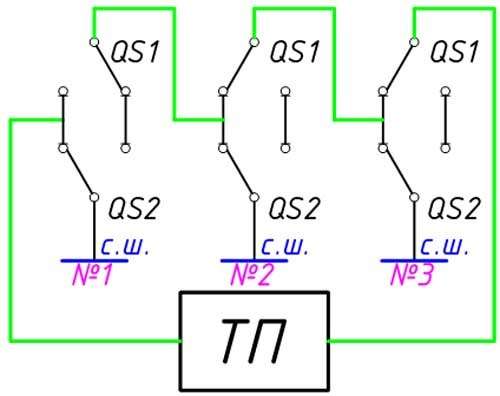
In normal mode, the power is evenly divided between the two inputs.
In order to understand why this circuit requires exactly two switches, we let you consider a number of possible emergency situations:
- Failure of one of the supply cable lines
In such a situation, the power supply to all multi-apartment residential buildings comes from one cable line.
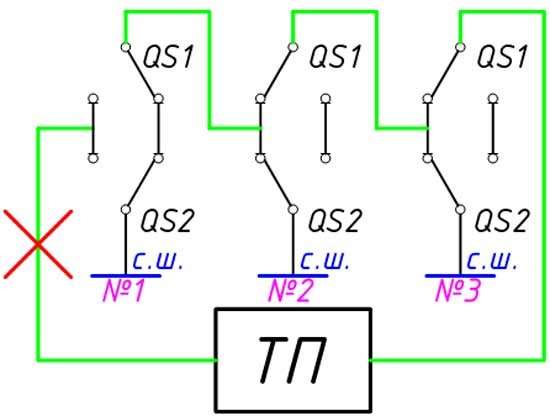
Specialists from the management company install the switches in the required position.
- Jumper failure
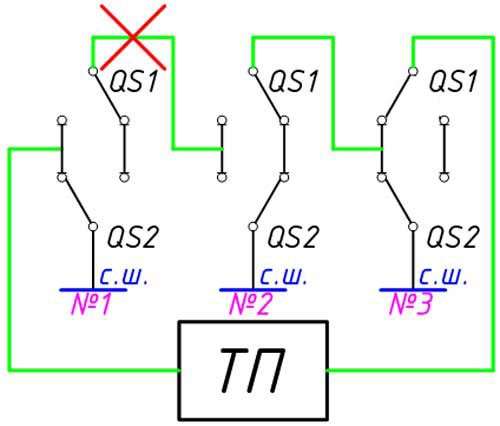
Workers are required to isolate from the power supply circuit the area where the accident occurred (for example, a short circuit occurred on the line). One part of the houses is powered by one cable line, and the second part of the residential buildings is powered by another. Instead of two changeover switches, you can use three regular ones.
Lighting standards

The norms and rules of street lighting are regulated by various regulations and GOST (state standards). These include:
- GOST R 55708-2013.
- GOST R 55707-2013.
- GOST 4677-82.
- GOST 28682-90.
- GOST IEC 60598-2-3-2012.
- GOST IEC 60598-2-5-2012.
- GOST IEC 60598-2-13-2011.
- GOST R 55706-2013.
- SNiP 23-05-95.
- MGSN 2.06-99.
- And others.
In such legal sources, the viewing angle of the light beam is regulated (if the distance between them is greater, more height of the poles will be required), illumination dimensions (the optimal height is taken into account and calculated), brightness (if the required light intensity is greater, then they need to be set lower than the expected level).
Street lighting standards in populated areas vary depending on the objects. The following are standard:
- The tilt angle is at least 80-90 degrees.
- The installation angle is respectively 30 Cd for 80 degrees and 10 Cd for 90 degrees (calculation is made at 1000 lm).
- The brightness is set to 10-50 cd depending on the tilt angle when calculating per 1000 LM.
Light with a motion sensor in the entrance of an apartment building
Lamps with a motion sensor, especially on staircases, are one of the ways to save the financial situation of each of those living in a high-rise building.
The light turns on only when a person approaches the maximum distance from the motion sensor (specified in the accompanying documents).
Some residents, when installing motion sensor lights, also install CCTV cameras. At the first stage, this causes additional material investments, but in the future it allows you to protect your life.
The light emanating from lamps with a motion sensor can scare even the most seasoned thief in the first seconds.
In this case, even the use of incandescent lamps will be financially justified for the following reasons:
- They have the property of instant inclusion;
- Provide sufficient illumination of staircases in response to movement;
- Installation does not require special skills;
- The light of the lamps complies with the standards set by SanPin.
The choice of lamps for lighting the entrance is carried out by voting by residents of the entrance.
Who receives complaints
If residents identify any shortcomings or violations, they can create an individual or collective request to eliminate them. Such complaints can be submitted to the service provider, state and municipal authorities within the established time limits.
Depending on the problem, it is recommended to indicate in the complaint the authorized body whose responsibilities include eliminating the deficiencies.
Sample complaint
The complaint must be written in writing and sent in person or via Russian post or email. There is no legally established form.
The complaint must include the required details (several problems can be identified in one document):
- In the header of the document, indicate the name and address of the location of the utility organization or state or municipal body, as well as the full names of the persons who signed the complaint.
- A descriptive part indicating all the shortcomings with links to legal norms and the word “Please.”
- Signatures of persons with transcripts.
- Date of preparation.
Based on this principle, an application for the installation of lighting poles and other equipment is also drawn up:
- In the “header” of the document, indicate the name and address of the location of the state or municipal body, as well as the full names of the persons who signed the application.
- A descriptive part indicating the installation location.
- Signatures of persons with transcripts.
- Date of preparation.
This is the basic information that residents will need to receive the full service.
Power supply categories
To better understand the differences in power supply schemes for a multi-storey building (both residential and any other), you need to know that power supply can be provided in different ways, differing significantly in reliability. The most difficult reliability category is the first. With it, residential buildings are powered by two cables. Each of them is connected to a separate transformer.
If one transformer or cable fails, the ATS (automatic transfer switch) device will immediately transfer all power to the working cable. Thanks to this, problems with the power supply will occur in a matter of seconds. After a group of electricians left and repaired the failed equipment, electricity supply is maintained as usual.

In order to correctly understand the various power supply schemes for residential buildings , you need to know about the three categories of ensuring the reliability of power supply to electrical installations. The simplest category is the third. It provides power to a residential building from a transformer substation via a single electrical cable. Moreover, in the event of an emergency, the interruption in the power supply to the house should be less than 1 day.
With the second category of power supply reliability, a residential building is powered by two cables connected to different transformers. In this case, if one cable or transformer fails, the power supply to the house while the fault is being eliminated is carried out through one cable. An interruption in power supply is allowed for the time necessary for the electrical personnel on duty to connect the loads of the entire house to the operating cable.
There are two types of power supply at home from two different transformers. Either the loads of the house are evenly distributed across both transformers, and in emergency mode they are connected to one, or in operating mode one cable is used, and the second is a backup. But in any case, the cables are connected to different transformers. If two cables are laid in the electrical panel of a house , one of which is a backup, but it is possible to connect these cables to only one substation transformer, then we have only the third category of reliability.
With the first category of power supply reliability, a residential building is powered by two cables, just as with the second category. But if a cable or transformer fails, the loads of the entire house are connected to the working cable using an automatic transfer switch (ATS).
There is a special group of electrical receivers (fire alarms, smoke removal systems in case of fire, evacuation lighting and some others), which must always be powered according to the first reliability category. For this purpose, backup power sources are used - batteries and small local power plants.
According to existing standards for the third category of reliability, electricity is supplied to houses with gas stoves with a height of no more than 5 floors, houses with electric stoves with the number of apartments in the house less than 9 and houses of gardening associations.
Electricity supply in the second reliability category applies to houses with gas stoves with a height of more than 5 floors and houses with electric stoves with more than 8 apartments.
According to the first reliability category, it is mandatory to supply electricity to heating points of apartment buildings, and in some buildings, elevators. It should be noted that the first category mainly supplies electricity to some public buildings: these are buildings with more than 2000 employees, operating rooms and maternity wards of hospitals, etc.
The figure shows the power supply diagram for four entrance houses, powered according to the second reliability category with a backup cable. The supply cables are switched using a reversing switch having positions “1”, “0” and “2”. In position "0" both cables are disconnected. The circuit breakers QF1...QF4 feed the lines that run along the access vertical risers, from which power is supplied to the apartments. General house loads: lighting of staircases, basements, lamps above the entrance doors to the entrances are powered by a separate group containing its own electricity meter.
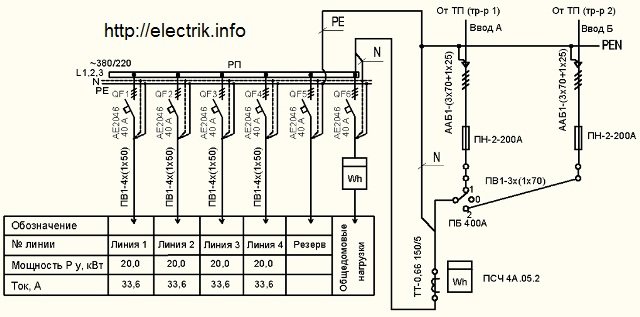
Depending on the number of apartments in the house, all electrical equipment can be placed in one electrical cabinet or in several.
Who maintains street lighting on poles
Street lighting is also maintained by public utilities.
But, payment for it can be made by local authorities (local government). The local administration of a locality is authorized by law to accept applications from citizens for the installation of poles and lanterns for street lighting. Such applications are considered within a procedural time frame of 30 days.
If an application is left unsatisfied, a citizen (or a group of citizens) has every right to file a claim in court. To do this, you must attach all documentation confirming the refusal to fulfill a legal request.
Who pays for the lighting of the local area of an apartment building?
All electricity bills are paid by residents of the apartment building. The total amount is divided by the number of apartments. In the receipt sent by the company, this service is designated as GDN (general household needs).
Receipts must be received monthly. Their distribution can be carried out in written or electronic form. Authorized persons (usually employees of public or private organizations) have the authority to deliver them by law.
If you change your address or do not receive payment documents, you must immediately contact your service provider. Otherwise, the citizen will need to pay fines and penalties.
Possibility of installing energy-saving lamps in the entrances of apartment buildings

An energy-saving lamp installed in the entrance provides significant energy savings. For 1 hour of uninterrupted operation, it consumes only 11 W, while a conventional incandescent lamp consumes 60 W.
But given its high cost, residents have to think about how to maintain functionality for a longer time. Since no one can insure themselves against acts of hooliganism, they have to make additional expenses by purchasing anti-vandal lamps.
In order for less electricity to be wasted and the lighting to last for a long time, you have to think not only about changing the lamps, but also the cartridges. The energy-saving cartridges have a built-in light sensor and microphone.
When the noise of footsteps appears, the light automatically turns on, and when they subside, it turns off. The same process occurs when natural light in the entrance of a residential building decreases or increases.
